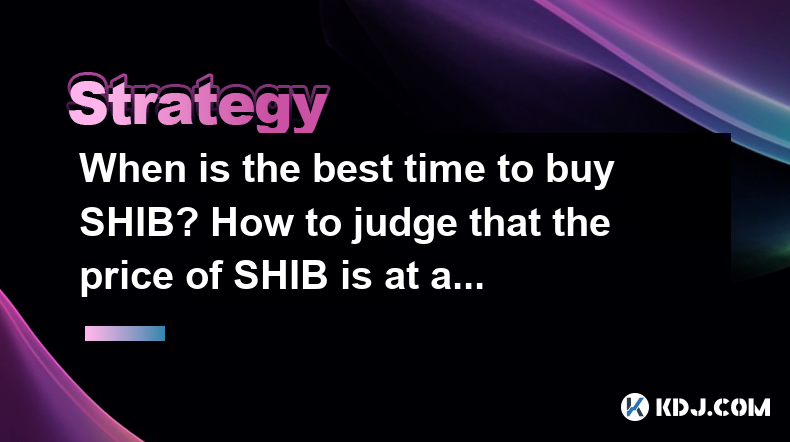-
 bitcoin
bitcoin $110918.433029 USD
-1.69% -
 ethereum
ethereum $3996.872473 USD
-2.43% -
 tether
tether $1.000594 USD
0.00% -
 bnb
bnb $1178.871834 USD
-2.38% -
 xrp
xrp $2.413973 USD
-3.47% -
 solana
solana $194.341461 USD
-4.24% -
 usd-coin
usd-coin $0.999963 USD
-0.03% -
 tron
tron $0.320092 USD
0.92% -
 dogecoin
dogecoin $0.196919 USD
-3.42% -
 cardano
cardano $0.669585 USD
-3.63% -
 hyperliquid
hyperliquid $37.485952 USD
-3.58% -
 ethena-usde
ethena-usde $1.000026 USD
-0.02% -
 chainlink
chainlink $18.018220 USD
-5.13% -
 bitcoin-cash
bitcoin-cash $523.879267 USD
-2.41% -
 stellar
stellar $0.324655 USD
-3.67%
When is the best time to buy SHIB? How to judge that the price of SHIB is at a low point?
To buy SHIB at a low point, monitor market cycles, use technical analysis like moving averages and RSI, and consider fundamental factors and sentiment.
Apr 28, 2025 at 08:57 pm

When is the best time to buy SHIB? How to judge that the price of SHIB is at a low point?
Determining the best time to buy Shiba Inu (SHIB) and identifying when its price is at a low point involves understanding market trends, technical analysis, and the broader crypto ecosystem. This article will delve into these aspects to help you make informed decisions about investing in SHIB.
Understanding Market Cycles
The cryptocurrency market, including SHIB, operates in cycles characterized by periods of growth and decline. Recognizing these cycles is crucial for timing your investments effectively. Bull markets are characterized by rising prices and increased investor enthusiasm, while bear markets are marked by falling prices and reduced interest.
To identify where SHIB is within its market cycle, you should monitor overall market sentiment, news affecting SHIB, and the performance of similar cryptocurrencies. For instance, if the broader market is entering a bull phase and SHIB is lagging, it might be a good time to buy as it could soon follow suit.
Technical Analysis for SHIB
Technical analysis involves studying historical price data and chart patterns to predict future price movements. Key tools for technical analysis include moving averages, support and resistance levels, and various indicators like the Relative Strength Index (RSI) and the Moving Average Convergence Divergence (MACD).
Moving Averages: The 50-day and 200-day moving averages are particularly useful. When the 50-day moving average crosses above the 200-day moving average, it's known as a 'golden cross,' which can signal a bullish trend. Conversely, a 'death cross' occurs when the 50-day moving average falls below the 200-day moving average, indicating a bearish trend.
Support and Resistance Levels: These levels are price points where SHIB tends to find buying or selling pressure. A break below support can indicate a potential low point, while a break above resistance can signal a potential high point.
RSI and MACD: The RSI measures the speed and change of price movements, with readings above 70 indicating overbought conditions and readings below 30 indicating oversold conditions. The MACD helps identify trend changes and momentum by showing the relationship between two moving averages of SHIB's price.
Fundamental Analysis
Fundamental analysis involves evaluating the underlying factors that could affect SHIB's value. This includes developments within the Shiba Inu ecosystem, such as new partnerships, technological upgrades, or changes in the token's supply.
For example, if SHIB announces a new integration with a major platform or a significant reduction in its circulating supply, it could signal a good time to buy. Conversely, negative news or a lack of progress might suggest waiting for a better entry point.
Sentiment Analysis
Market sentiment can significantly influence SHIB's price. Tools like social media sentiment analysis and Google Trends can help gauge public interest and sentiment towards SHIB. High positive sentiment often precedes price increases, while negative sentiment can lead to price drops.
For instance, if there is a surge in positive tweets about SHIB or increased search volume for 'buy SHIB,' it might indicate growing interest and a potential price increase. Conversely, a decline in sentiment could suggest a good time to buy at a lower price.
Volume Analysis
Trading volume is another critical factor in determining when to buy SHIB. High trading volume often accompanies significant price movements. If SHIB's price is declining on low volume, it might indicate a lack of selling pressure and a potential low point. Conversely, if the price is declining on high volume, it might suggest strong bearish sentiment and a need for caution.
To identify potential low points, look for periods where the price stabilizes or starts to recover on increasing volume. This could indicate that buyers are stepping in and that the price may be nearing a bottom.
Practical Steps to Buy SHIB at a Low Point
When you believe SHIB is at a low point and ready to buy, follow these steps:
Choose a reputable exchange: Platforms like Binance, Coinbase, or KuCoin offer SHIB trading. Ensure the exchange is secure and supports your preferred payment methods.
Set up an account: Register on the chosen exchange, complete the KYC (Know Your Customer) process, and secure your account with two-factor authentication.
Deposit funds: Transfer fiat currency or another cryptocurrency to your exchange account. If using fiat, consider the conversion rates and fees.
Place an order: Decide between a market order (buys at the current market price) or a limit order (buys at a specified price). If you believe SHIB is at a low point, a limit order might be preferable to ensure you buy at your desired price.
Monitor your investment: After purchasing, keep an eye on SHIB's price movements and be prepared to adjust your strategy based on new developments and market conditions.
FAQs
Q: How can I stay updated on SHIB news and developments?A: To stay informed about SHIB, follow official Shiba Inu social media accounts, subscribe to crypto news websites, and join SHIB-focused communities on platforms like Reddit and Telegram. Regularly checking these sources will help you stay on top of the latest news and announcements.
Q: Is it safe to hold SHIB in a hardware wallet?A: Yes, holding SHIB in a hardware wallet is considered one of the safest ways to store your cryptocurrency. Hardware wallets like Ledger and Trezor provide offline storage, reducing the risk of hacking. Ensure you follow the manufacturer's instructions carefully to set up and use your wallet securely.
Q: Can I use technical indicators to predict SHIB's price with certainty?A: No, technical indicators are tools that help you make more informed decisions, but they cannot predict SHIB's price with certainty. The cryptocurrency market is highly volatile and influenced by many unpredictable factors. Always use technical analysis as part of a broader investment strategy.
Q: What should I do if SHIB's price continues to drop after I buy?A: If SHIB's price continues to drop after you buy, assess whether the drop is due to temporary market fluctuations or more significant issues affecting SHIB's long-term value. You may decide to hold if you believe in SHIB's future potential, or you might consider selling to minimize losses. Regularly review your investment thesis and adjust your strategy accordingly.
Disclaimer:info@kdj.com
The information provided is not trading advice. kdj.com does not assume any responsibility for any investments made based on the information provided in this article. Cryptocurrencies are highly volatile and it is highly recommended that you invest with caution after thorough research!
If you believe that the content used on this website infringes your copyright, please contact us immediately (info@kdj.com) and we will delete it promptly.
- Uncirculated Queen Elizabeth £2 Coins: A Collector's Guide
- 2025-10-16 12:25:12
- Jimmie Bones' Battle with ALS: Kid Rock's Heartfelt Support
- 2025-10-16 12:25:12
- Crypto Market Rollercoaster: Fear & Greed, DeFi Dips, and the Next Big Thing
- 2025-10-16 12:30:01
- Ethereum Foundation, Morpho Protocol, and Treasury Management: A New Era of DeFi Engagement
- 2025-10-16 12:30:01
- Larry Fink and BlackRock: Tokenizing All the Assets, Baby!
- 2025-10-16 11:05:12
- Meme Coin Mania: MoonBull, FLOKI, and SHIB – What's the Buzz?
- 2025-10-16 09:10:00
Related knowledge

Practical parameter settings for a Bitcoin multi-timeframe moving average system
Sep 18,2025 at 10:54pm
Optimizing Timeframe Combinations for Bitcoin Trading1. Selecting appropriate timeframes is crucial when building a multi-timeframe moving average sys...

How can I filter out false breakouts in Dogecoin high-frequency trading?
Sep 22,2025 at 01:00am
Understanding False Breakouts in Dogecoin Trading1. A false breakout occurs when Dogecoin's price appears to move beyond a defined support or resistan...

Techniques for identifying tops and bottoms in the Bitcoin on-chain NVT model
Sep 20,2025 at 07:54pm
Understanding the NVT Model in Bitcoin Analysis1. The Network Value to Transactions (NVT) ratio is often described as the 'P/E ratio' of the cryptocur...

What does the surge in open interest in Bitcoincoin futures mean?
Sep 20,2025 at 11:18pm
Understanding the Surge in Dogecoin Futures Open Interest1. A surge in open interest within Dogecoin futures indicates a growing number of active cont...

How can I use the Ethereum USDT premium to gauge market sentiment?
Sep 18,2025 at 11:55pm
Understanding the Ethereum USDT Premium1. The Ethereum USDT premium refers to the price difference between USDT (Tether) traded on Ethereum-based plat...

What should I do if Ethereum staking yields decline?
Sep 20,2025 at 06:18am
Understanding the Causes Behind Declining Ethereum Staking Yields1. The Ethereum network transitioned to a proof-of-stake consensus mechanism with the...

Practical parameter settings for a Bitcoin multi-timeframe moving average system
Sep 18,2025 at 10:54pm
Optimizing Timeframe Combinations for Bitcoin Trading1. Selecting appropriate timeframes is crucial when building a multi-timeframe moving average sys...

How can I filter out false breakouts in Dogecoin high-frequency trading?
Sep 22,2025 at 01:00am
Understanding False Breakouts in Dogecoin Trading1. A false breakout occurs when Dogecoin's price appears to move beyond a defined support or resistan...

Techniques for identifying tops and bottoms in the Bitcoin on-chain NVT model
Sep 20,2025 at 07:54pm
Understanding the NVT Model in Bitcoin Analysis1. The Network Value to Transactions (NVT) ratio is often described as the 'P/E ratio' of the cryptocur...

What does the surge in open interest in Bitcoincoin futures mean?
Sep 20,2025 at 11:18pm
Understanding the Surge in Dogecoin Futures Open Interest1. A surge in open interest within Dogecoin futures indicates a growing number of active cont...

How can I use the Ethereum USDT premium to gauge market sentiment?
Sep 18,2025 at 11:55pm
Understanding the Ethereum USDT Premium1. The Ethereum USDT premium refers to the price difference between USDT (Tether) traded on Ethereum-based plat...

What should I do if Ethereum staking yields decline?
Sep 20,2025 at 06:18am
Understanding the Causes Behind Declining Ethereum Staking Yields1. The Ethereum network transitioned to a proof-of-stake consensus mechanism with the...
See all articles


























![Web3 Crypto Market Morning Report: The market is in decline, altcoins have fallen by more than 5%, Binance compensation has been received, and Memes on the Bnb chain have collectively plummeted [Vic TALK Issue 1444] Web3 Crypto Market Morning Report: The market is in decline, altcoins have fallen by more than 5%, Binance compensation has been received, and Memes on the Bnb chain have collectively plummeted [Vic TALK Issue 1444]](/uploads/2025/10/16/cryptocurrencies-news/videos/web-crypto-market-morning-report-market-decline-altcoins-fallen-binance-compensation-received-memes-bnb-chain-collectively-plummeted-vic-talk-issue/68f043c9c8b44_image_500_375.webp)















































